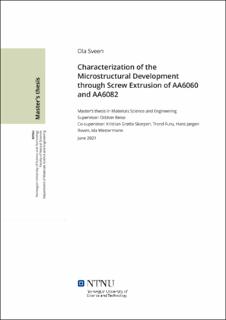| dc.contributor.advisor | Reiso, Oddvin | |
| dc.contributor.advisor | Skorpen, Kristian Grøtta | |
| dc.contributor.advisor | Roven, Hans Jørgen | |
| dc.contributor.advisor | Furu, Trond | |
| dc.contributor.advisor | Westermann, Ida | |
| dc.contributor.author | Sveen, Ola | |
| dc.date.accessioned | 2021-10-05T17:42:13Z | |
| dc.date.available | 2021-10-05T17:42:13Z | |
| dc.date.issued | 2021 | |
| dc.identifier | no.ntnu:inspera:80234703:24437210 | |
| dc.identifier.uri | https://hdl.handle.net/11250/2787936 | |
| dc.description.abstract | Økt resirkulering av materialer vil spille en avgjørende rolle i å fremskynde overgangen til en mer bærekraftig fremtid og sirkulær økonomi. Skruekstrudering er en nyskapende resirkuleringsteknologi som omdanner skrap til ekstruderte profiler. For å industrialisere teknologien og utvikle robuste mikrostrukturmodeller trengs det økt forstålse av hva som skjer i materialet under skruekstruderingen. I denne oppgaven har det blitt gjennomført skruekstrudering av AA6060 og AA6082 med CO2 som dekkgass. Materiale fra granuler til ekstruderte profiler har blitt karakterisert. Rekrystallisering og intermetalliske partikler har blitt undersøkt gjennom skruekstruderen, i tillegg til kornstruktur, analyse av dispersoider og presipitater, og mekanisk testing av ekstruderte profiler. Resultater har blitt sammenlignet med en standard direkte ekstrudert 6082.
Resultatene viser at utvikling av kornsturktur gjennom skruekstrudering er sammenlignbar med standard ekstrudering. For 6060 ble det observert enten grove langstrakte korn eller ekviaksede korn i soner med langsom materialflyt, og smale langstrakte korn i skjærintensive soner. Siden materialet fra ekstruderingskammeret ble sakte avkjølt, er det sannsynlig at mikrostrukturen til 6060 skyldes statisk rekrystallisering. En hypotese for oppbrytning av AlFeSi-partikler gjennom skruekstruderen ble undersøkt men ikke bekreftet gjennom analyser i lysmikroskop.
Skruekstruderte profiler viste en bedre motstand mot rekrystallisering sammenlignet med standard ekstruderte profiler. Det ble foreslått at lavere tøyningshastighet og høyere temperatur under skruekstrudering var årsaken. Enkelte skruekstruderte prøver med CO2 som dekkgass viste mindre tegn til porøsitet, men effekten kunne ikke tilskrives CO2 alene, grunnet noe varierende temperatur under skruekstrudering og tykkelse på granuler. Partikkelanalyser viste at standard ekstrudert 6082 hadde mellom 3 og 9 ganger høyere antallstetthet av dispersoider sammenlignet med skruekstrudert 6082. Videre analyser ga ikke et entydig svar på hvorfor. Strekktesting viste at skruekstrudert 6082 nådde høyere verdier for flytespenning og strekkfasthet sammenlignet med standard ekstrudert 6082, begge i T6-tilstand. Mens skruekstrudert 6082 nådde rundt 350 MPa i strekkfasthet, ble det for standard ekstrudert 6082 bare oppnådd rundt 290 MPa. Fraktografi viste sterk krystallografisk anisotropi i standard ekstrudert 6082 i T6-tilstand, noe som ble antatt
å være hovedårsaken til forskjellen i resultater fra strekktesting. | |
| dc.description.abstract | Increased recycling of materials will play a key role in accelerating the transition towards a more sustainable future and circular economy. The metal continuous screw extrusion technology (MCSE) is a novel solid-state recycling technology, transforming scrap into extruded profiles. A key part of industrializing the technology and developing robust microstructural models is to understand the microstructural development through the screw extruder. In this study, AA6060 and AA6082 have been screw extruded with CO2 as cover gas. A full characterization, from feedstock material to screw extruded profiles, has been performed. Recrystallization behaviour and evolution of intermetallic particles through the screw extruder have been assessed, in addition to grain mapping, inspection of dispersoids and precipitates, and mechanical testing of the screw extruded profiles. A standard ram extruded 6082 profile was used as a comparison.
The results from this study show that grain structure development through the screw extruder is comparable to the standard ram extrusion process. For the 6060 trial it was found that material located in zones with slow replacement consisted of either coarse elongated grains or equiaxed grains, and small elongated grains in shear intensive zones. Since the aluminium butt sections from the screw extrusion chamber were slowly cooled from 560 C, it seemed likely that the 6060 material had initiated static recrystallization. A hypothesis for fragmentation of AlFeSi-particles through the screw extruder was followed up but not confirmed by inspection in light optical microscopy.
Screw extruded profiles displayed greater recrystallization resistance compared to ram extruded samples. This was suggested to be caused by lower strain rates and higher temperatures during screw extrusion, thus a smaller driving force for recrystallization. CO2 had a seemingly positive effect on porosity, but could not be singled out as the only factor, as temperature during screw extrusion and thickness of feedstock material varied. In ram extruded 6082 particle analysis showed between 3 and 9 times higher number density of dispersoids compared to screw extruded 6082. Further analyses did not provide a clear answer as to why. Screw extruded 6082 outperformed ram extruded 6082 in tensile testing, T6 condition. While screw extruded 6082 reached tensile strengths of about 350 MPa, ram extruded 6082 only reached about 290 MPa. Fractography suggested strong crystallographic anisotropy in ram extruded 6082 samples in T6 condition, which was believed to be the main reason causing the difference. | |
| dc.language | eng | |
| dc.publisher | NTNU | |
| dc.title | Characterization of the Microstructural Development through Screw Extrusion of AA6060 and AA6082 | |
| dc.type | Master thesis | |
